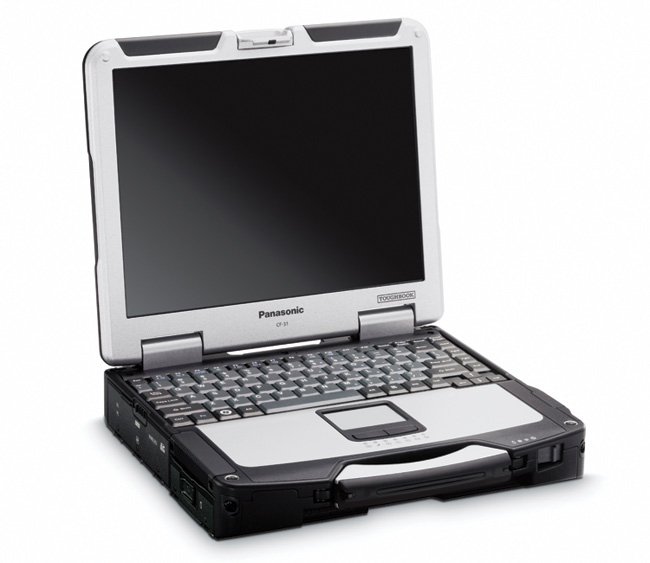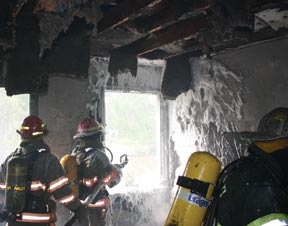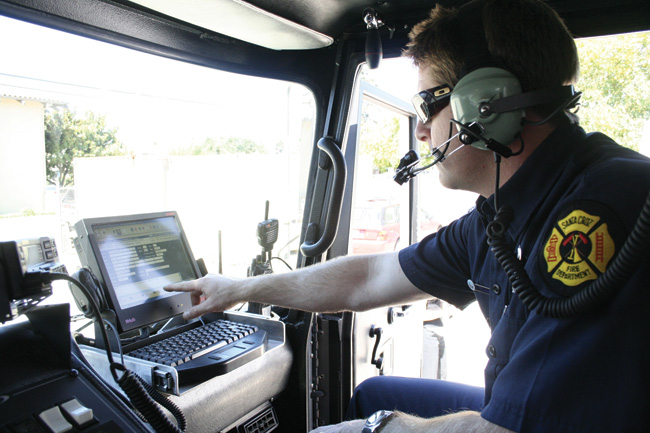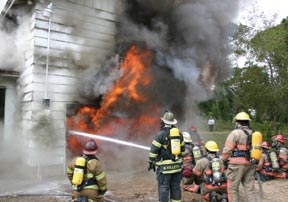 |
| Panasonic’s new Toughbook CF31 is significantly improved over the CF30. |
 |
| Xplore Technologies Corporation is preparing to launch the Itronix 5 tablet PC, which will have features not found on the iX104C4, pictured above. |
 |
| Hub-Data911 sells M6 modular computers with three components that can be located separately – the computer, the display and the keyboard/touchpad interface. |
 |
| OptiMetrics’ ADASHI software (Automated Decision Aid System for Hazardous Incidents) originated as a U.S. Army product. |
Mobile computers and software have become essential elements in today’s fire and emergency medical service vehicles. As a result, fire and EMS departments have become tech-savvy and are looking for innovations to make their efforts more effective and safer.
Of course, the environments in which fire and EMS operate are far harsher than those of your average accounting firm. That is why many manufacturers have stepped up to produce first responder-specific items, which are built to take abuse and keep running regardless.
Here’s a roundup of some of those products, with a focus on what’s new and useful for fire/EMS.
The Panasonic Toughbook computer is a familiar sight in many fire and EMS vehicles. The newest version of this rugged stalwart, the Toughbook CF31, looks much the same as its predecessor, the Toughbook CF30. But don’t be fooled by appearances; the CF31 is much more machine for the money.
“We asked our engineers to come up with a new model with much more computing power, a significantly brighter screen, a faster recharge cycle, a longer battery life and the ability to withstand even tougher conditions,” said Dave Poulan, senior business manager for Panasonic Solutions for Government. “And we told them to keep the price the same.”
The new CF31 hits all those targets. First, it is equipped with a desktop quality Intel i5 CPU chip rather than the Celeron found in the CF30 (and many consumer laptops). “The i5 is a full desktop CPU, which means it is faster and more capable than the lower-voltage Celeron,” Poulan said. “This gives you 20 percent faster processing speed and the headroom to run more applications at the same time.”
The second improvement is the CF31's display, which has been boosted from 1,000 to 1,200 nits, a measure of visible light intensity. This results in a brighter, easier-to-read display, even in direct sunlight.
Next up is a new battery pack, which offers 90 watts of power, compared to the CF30's 60 watts, and the ability to charge fully in just 3-1/2 hours. Finally, the CF31 has been engineered to pass even tougher testing standards, including the ability to withstand a six-foot drop on any part of its case. The CF30 and previous generations of Toughbooks were rated for a three-foot drop.
“We decided to boost the testing standards on the CF31 after seeing how well our U1 stood up to them,” Poulan said.
The Panasonic U1 is an “Ultra Rugged Handheld PC.” It can be used in a vehicle, but is designed to be carried by officers in the field. It has a 5.6-inch widescreen display, a built-in QWERTY keyboard and WiFi connectivity. “The U1 comes with dual batteries, which are hot swappable,” Poulan said. “This means that you can take one out and replace it while the U1 keeps running on the other.”
In tandem with the Panasonic Toughbook CF31's release, Havis unveiled a new docking station for it and the CF30. Branded as the DS-PAN-111, Havis billed the mount as being “the lightest weight of any comparable product, taking up less cabin space than any other dock currently available.”
The DS-PAN-111 has passed MIL-STD-810G shock and vibration tests, cycle testing, a 30-mph crash test (SAE J1455) and is EMC (electromagnetic compatibility) compliant.
Xplore Technologies Corporation has gained a substantial foothold in the public safety market with its rugged Itronix tablet PCs. “We are currently shipping the fourth generation of this computer, but are about to launch the newest version, the Itronix 5,” said Dwayne Lum, Xplore’s director of marketing and new product initiatives. “The Itronix 5 comes with a whole slew of new features that we’ve devised in response to requests from the fire and EMS communities.”
Among those new features is a “brand new LCD display technology,” Lum said. “This technology improves the viewing angle of the screen from 45 to 60 degrees. This means that you can be further off to the side of the display and still see it clearly.”
The Itronix 5 has also been loaded with RAID disk drive technology. This means that the unit has two functioning drives. Should one of them fail – and all drives fail eventually, be they spinning disk or solid state – the other will keep the PC running.
The Itronix 5 is built to connect to 3G cellular and mobile broadband networks in addition to WiFi, meaning the laptop can use commercial wireless networks to link back to the station and to the Web. Finally, the Itronix 5 has been designed to fit into a lower profile docking station inside cars and trucks to provide more room for the occupants. “At the same time,” Lum said, “the Itronix 5 is backwards compatible with earlier docking stations, so adding it into an existing vehicle is no problem.”
Dell is a relative newcomer to the ruggedized laptop market, but it has asserted itself with a vengeance. The company offers two models – the Latitude E6400 XFR laptop and the Latitude XT2 XFR with rotating display that can serve as a laptop or touchscreen tablet PC.
“Both of these units are encased in our Ballistic Armor Protection System that meets or exceeds real world and military standards such as MIL-STD-810F,” said Rick Perez, Dell’s Latitude product marketing manager. “Our PrimoSeal technology allows users to seal off open ports to protect against dust and water. It offers the highest combined level of ingress protection rating (IP65) of any notebook in its class.”
Rugged Notebooks makes a range of tough notebooks and tablet PCs for fire and EMS use. A case in point is the RNB Rover 13.3-inch widescreen convertible notebook, which meets the MIL-STD 810F specification for drop, shock and spill resistance. It is also IP54 rated for liquid and dust protection. The Rover is housed in magnesium alloy and has protection covers over every port and connector.
Being “convertible,” the RNB Rover’s screen can be rotated and then folded down over the keyboard to let the unit serve as a ruggedized tablet PC. The unit comes with a shock-mounted removable hard drive, a TPM (trusted platform module) for data encryption and fingerprint recognition as standard features.
Hub-Data911 takes a different approach to in-vehicle computing. Rather than selling ruggedized laptops, the company sells M6 modular computers, which are designed to be installed in cars and trucks. Data911 M6 computers are comprised of three sections – the actual computer (the processor box), the display and the rugged keyboard/touchpad interface.
“The modular PC can be installed to suit your requirements and space limitations,” said Scott Beisner, Hub-Data911's director of research and development. “You can put the processor box in the glove compartment or in the trunk. You can install the display on the dashboard or a pedestal. And you can put the keyboard/touchpad wherever is most convenient.”
He compared putting a laptop computer in a car to using a boom box for an in-vehicle stereo system. “It works, but it doesn’t work as well as an audio system specifically designed for your vehicle,” he said. “That’s the logic behind our modular system. You can put elements where you need them. And you can switch out one section of the computer – like the display – while retaining the rest. This saves money and installation/configuration time.”
Hub-Data911 makes displays in a range of sizes to let fire and EMS departments choose whichever display works best for them. It is also possible to use two displays in a vehicle – a smaller one on the dash and a larger one in the back seat. On the software side, Hub-Data911's newest modular computers use Google Maps to allow GPS-equipped vehicles see their locations and those of the same fleet in real time.
OptiMetrics’ ADASHI (Automated Decision Aid System for Hazardous Incidents) software originated as a U.S. Army product to aid troops in coping with CBRN (chemical, biological, radiological and nuclear) incidents. The software was developed with OptiMetrics’ assistance. When the company decided it wanted to bring ADASHI to the first responder market, the Army patented it and then licensed OptiMetrics to release ASASHI publicly. Since then, OptiMetrics has refined the original ADASHI program to its current First Response 3.0 version.
“ADASHI First Response allows you to handle CBRN incidents either directly or through dispatch,” said Alex Menkes, the company’s program manager for ADASHI. “You can use it to create and then display complex maps of specific sites, showing first responders where hazards are located and what kinds of hazards they are. You can also search the database for specific items, like hospitals within the incident zone, and track the location of first responder vehicles in real time and the location of GPS-equipped personnel.”
ADASHI First Response and the company’s two other versions (ADASHI Lite and ADASHI Command Post) come with complete NAVTECH maps for all of North America. An important point: The Department of Homeland Security has certified ADASHI to be a “Qualified Anti-Terrorism Technology,” which means an unbiased government sponsored team validated the operational utility of the software within a tabletop terrorist exercise.
More Fire Apparatus Current Issue Articles
More Fire Apparatus Archives Issue Articles

